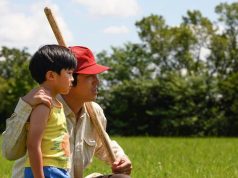Perhaps the most significant accomplishment in Debra Granik’s “Winter’s Bone” is the way she conveys a sense of place. The film, a compelling story of steely determination, is set amid ramshackle houses and meth trailers in rural Missouri, and it practically takes you there. (Not that you’d want to go.) This authenticity doesn’t just come from shooting on location. It’s getting the details right: the way people look, talk, and dress; the kind of dogs they own, the type of vehicles they drive. Not having been to this part of the country, I can’t say for sure whether Granik has captured it accurately. The point is that it feels genuine. The palpable sense that this world exists makes it easier to be drawn into it.
Based on Daniel Woodrell’s novel and adapted by Granik and Anna Rosellini, “Winter’s Bone” transports a film noir plot to the Ozarks. Seventeen-year-old Ree Dolly (Jennifer Lawrence) takes care of her little brother and sister, ages 12 and 6, as well as their mother, who is incapacitated by an unspecified mental illness. Ree’s father, Jessup, is absent — which is usually for the best, since he’s a producer and enthusiast of meth, or “crank.”
At the moment, however, Jessup’s presence is required. He put up the family’s house as his bond the last time he was arrested, and now he’s disappeared, days before his court appearance. If he doesn’t show up, the family loses the house. It’s up to Ree to find him, dead or alive.
Like the private detectives of yore, Ree checks her daddy’s usual haunts, asking if anyone has seen him. Everyone in the region seems to be related to everyone else, though whatever kinship they once felt has been ruined by years of drug use, hard living, and poverty. Jessup’s brother, Ree’s uncle Teardrop (John Hawkes) — this is the sort of place where a man might be named Teardrop — is particularly menacing in his insistence that Ree drop the whole thing and stop investigating. When she says she wants to visit meth-cooker Little Arthur’s place to see what he knows, Teardrop says, “That’s a real good way to end up et by hogs, or wishin’ you was.”
But Ree must persist or her family will be homeless. Already accustomed to being the responsible adult in her home, she’s resourceful and methodical, but she’s still a 17-year-old girl. There are moments in Jennifer Lawrence’s impressive performance when she starts to show the cracks in Ree’s resilient facade, when the desperation starts to turn to panic. When rays of hope shine through — and they do — we’re as grateful as she is.
Granik’s first film, “Down to the Bone” (she has a thing for bones, I guess), was also bleak: It starred Vera Farmiga as a housewife addicted to cocaine. My review of it began:
“A film like ‘Down to the Bone,’ about the stark reality of drug addiction, couldn’t be set in spring or summer. To get the full impact, you need the desolation of winter: the barren trees, the bleak skies, the grayish slush on the sidewalks.”
There aren’t any sidewalks to speak of in “Winter’s Bone,” and drug addiction isn’t the central focus, but everything else applies. “Winter’s Bone” creates a mood, a tone, a feeling that’s hard to shake off. The particulars of Ree’s quest are intriguing enough to keep us interested in where the story will go, but the film’s real strength is its detail-perfect evocation of a particular time and place.
B+ (1 hr., 40 min.; )





